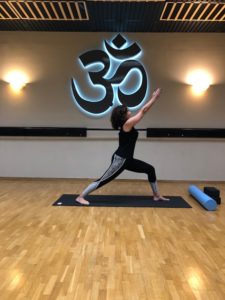
Sitting for long periods, distance running, sprinting, power walking, and even doing too many sit-ups can result in a tight and imbalanced psoas. Yoga is very important to keep your psoas muscles balanced and stretched.
- Karen Britton
Above: 1. Warrior one 2. Restorative psoas stretch with back support. 3. Restorative psoas stretch and back bend
And It Will be Kind to You.
The food you eat may not be the only thing affecting your digestion and elimination!!
The psoas (pronounced SO-as) is one of the most important muscles in your body. Without it, you wouldn’t be able to get out of bed. Before we get into how it affects digestion, let us understand where it is in your body.
The psoas connects your torso to the lower half of the body. This muscle stabilizes the spine and affects posture. It connects from your thoracic spine L 12 to L 5 lumbar, then through to the pelvis, interior sacroiliac joint, and femur bone. Your diaphragm muscle also connects to your psoas. These connections allow you to walk and breathe. A tight psoas can cause shallow breathing, which limits the amount of oxygen taken in and encourages over usage of your neck muscles.
When under we’re under stress, our psoas contracts. Over-contracting may very well cause an imbalanced psoas and may lead to neck and back pain as well as possible knee pain.
Healthy psoas muscles support your internal organs. They work like hydraulic pumps allowing blood and lymph to be pushed in and out of your cells.
A tight psoas can contribute to or even cause constipation. A large network of lumbar nerves and blood vessels passes through and around the psoas. Psoas tightness can interfere with blood flow and nerve impulses to the pelvic organs and legs. When these muscles are tight your torso shortens, decreasing space for your internal organs, and this affects food being absorbed and elimination. Yoga, with mindful breathing, stretches the psoas and creates physical space within the body.
An unhealthy psoas can leave you feeling exhausted. When breathing properly, the diaphragm moves, and your psoas muscles massage your kidneys and adrenal glands, stimulating blood circulation. When the psoas is unbalanced, your kidneys and adrenal glands become unbalanced, causing physical and emotional exhaustion.
Sitting for long periods, distance running, sprinting, power walking, and even doing too many sit-ups can result in a tight and imbalanced psoas. Yoga is very important to keep your psoas muscles balanced and stretched. Yoga practice teaches proper breathing and helps to reduce stress. With yoga and meditation, you learn how to relax. You cultivate new habits on how to deal with stressful situations.
The video which accompanies this article (see below) gives you some yoga postures that can help stretch and maintain a healthy and balanced psoas muscle.
In addition to these postures, a properly aligned plank pose, done often in yoga, and held for longer periods, can strengthen your core and back while keeping your psoas open. This can be in conjunction with your sit-ups and balancing out your core workout.
Remember, you don’t have to be flexible to do yoga, it makes you flexible!
Watch the Video:
Sponsored Links
About the Author

Karen Britton
Karen Britton is a certified Yoga Instructor and a regular contributor to Fit to Print. She teaches Yoga classes and programs at Fitness Incentive.











